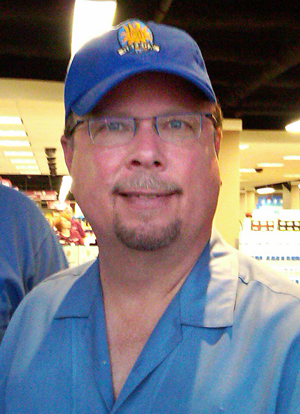Bell’s and Badgerow: the Origins of Midwest Microbrewing

Larry Bell, founder of Bell’s Brewery.
A teenage Larry Bell first discovered a wider world of beer in the mid-1970s when his older brother, who lived in Washington, D.C., snuck him into that city’s old Brickskeller restaurant, which then held the Guinness world record for most commercially available beers (1,072).
By 1980, the 22-year-old Bell, a native of the Chicago area, was working at the Sarkozy Bakery in Kalamazoo, Mich., where a coworker introduced him to homebrewing. Bell took a shine to the hobby, which in turn led him to take a fateful tour of the Real Ale Co. and ask its principal founder a few questions.
Ted Badgerow, a 31-year-old cook and choir director, had co-launched the brewery in early 1982 in the old clock-tower building of the small lower-Michigan town of Chelsea, about 20 miles west of Ann Arbor. Real Ale was the first independently owned brewery in not only Michigan, but the entire Midwest to make small batches of beer using traditional ingredients—what the newspapers were just starting to call “microbrewing” or “microbreweries.”
A friend had once offered Badgerow a tasty, refreshing beer after a long bike ride, a beer so good that Badgerow mistook it for an import. No, the friend said, it was his homebrew. Gordon Averill was another buddy. His family’s Michigan dairy farm was struggling amid a general commodities slump when Badgerow worked there in the summer of 1981.
A frustrated Averill surveyed the dairy’s equipment, including the tanks, one day that summer. “I’m going to get rid of all of this,” he told Badgerow, “and I probably won’t make 10, 20 bucks on it. What am I going to do?”
Badgerow the homebrewer had an idea. “If we filled it with beer, think how much we could sell that for.”
That did it. The duo raised $12,000 as seed money and located in the Chelsea clock tower space (the hardness of the town’s water was a plus, too). They sought advice from the handful of breweries already doing what they were planning on doing, including the early forces behind the Boulder Brewing Co. in Colorado. They got the necessary federal papers, but then hit a wall with the state.
It had been about a quarter-century since someone had applied for a brewery license in Michigan. Which form or forms did you even fill out? No one seemed to know. Luckily, Badgerow had a friend in his choir whose brother was a state legislator. The requisite red tape cut, Badgerow found himself skipping down the glazed marble of a government building, brewery license in hand, a bemused Averill walking more slowly beside him.
They immediately sold several cases of the English-style bitters that Badgerow had bottled, by hand, four at a time in old Bass, Guinness and Harp bottles he got for cents on the dollar. The visitors started soon after the licensing, too, including other established microbrewers and, bizarrely enough, pop-rock duo Hall & Oates, which interrupted a Canadian tour to buy 70 cases.
The Real Ale Co. was so novel that Time magazine sent a reporter in mid-1983. “I just crank up the stereo, stoke up the boiler and brew some ale,” was how Badgerow explained his simple, yet revolutionary ethos for what was then the largest U.S. newsweekly.
Larry Bell’s own visit to the Real Ale Co. helped spur him to launch what he originally called the Kalamazoo Brewing Co., incorporating with Michigan in early July 1983. That brewing company was actually a homebrew-supply shop. Soon, however, Bell was collecting investors and a 15-gallon commercial soup pot for a brewing kettle, an echo of Badgerow and Averill’s secondhand dairy equipment.
In August 1985, in three rooms of an old plumbing warehouse on East Kalamazoo Avenue in Kalamazoo proper, Bell was brewing test batches of English ales for what was then simply called Bell’s Brewery. Sales via secondhand bottles—another echo of the older Chelsea operation—began the following month.
Within a year, Bell’s Brewery was the oldest microbrewery between the East Coast and the Rocky Mountains. Why? Despite high demand, the Real Ale Co. could not find the funding for a necessary expansion. It went under in 1986.
An earlier version of this story incorrectly stated that Larry Bell graduated from Kalamazoo College, and that the referenced homebrew supply shop was in Galesburg. The copy above reflects these changes.
Read more Acitelli on History posts.
Tom Acitelli is the author of The Audacity of Hops: The History of America’s Craft Beer Revolution. His new book, American Wine: A Coming-of-Age Story, is available for pre-order. Reach him on Twitter @tomacitelli.

Did Larry Bell Graduate from Harlem High School in Rockford,Il? If so a classmate of mine from West High School (class of 77) recently found his Diploma and posted it on Facebook.It was found in an old car that he was going to junk.He is trying to find the owner.
i went there and purchases a dozen beers—still have bottles—somewhere i have a Real Ale stock certificate–i think i paid $5–great beer- i took a SBA sponsered class at Mukegon Community College in 80’s–we had to design a business–so I designed a brewey–even visited makers of brewing equipment when I was in Wisconsin–got an A in class–projects were reviewed by bank officiers–funny but I even had $50000 of my own money to start–was turned down flat by all banks–never proceeded with idea–now everywhere